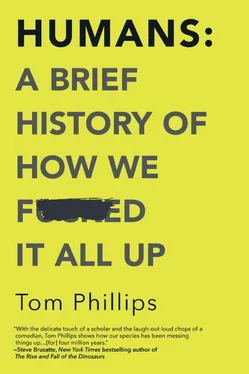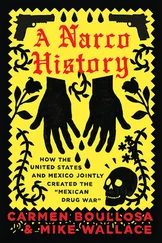Tom Phillips - Humans - A Brief History of How We F*cked It All Up
Здесь есть возможность читать онлайн «Tom Phillips - Humans - A Brief History of How We F*cked It All Up» весь текст электронной книги совершенно бесплатно (целиком полную версию без сокращений). В некоторых случаях можно слушать аудио, скачать через торрент в формате fb2 и присутствует краткое содержание. Город: Toronto, Год выпуска: 2019, ISBN: 2019, Издательство: Hanover Square Press, Жанр: История, Юмористические книги, на английском языке. Описание произведения, (предисловие) а так же отзывы посетителей доступны на портале библиотеки ЛибКат.
- Название:Humans: A Brief History of How We F*cked It All Up
- Автор:
- Издательство:Hanover Square Press
- Жанр:
- Год:2019
- Город:Toronto
- ISBN:978-1-48805-113-5
- Рейтинг книги:4 / 5. Голосов: 1
-
Избранное:Добавить в избранное
- Отзывы:
-
Ваша оценка:
- 80
- 1
- 2
- 3
- 4
- 5
Humans: A Brief History of How We F*cked It All Up: краткое содержание, описание и аннотация
Предлагаем к чтению аннотацию, описание, краткое содержание или предисловие (зависит от того, что написал сам автор книги «Humans: A Brief History of How We F*cked It All Up»). Если вы не нашли необходимую информацию о книге — напишите в комментариях, мы постараемся отыскать её.
Humans: A Brief History of How We F*cked It All Up — читать онлайн бесплатно полную книгу (весь текст) целиком
Ниже представлен текст книги, разбитый по страницам. Система сохранения места последней прочитанной страницы, позволяет с удобством читать онлайн бесплатно книгу «Humans: A Brief History of How We F*cked It All Up», без необходимости каждый раз заново искать на чём Вы остановились. Поставьте закладку, и сможете в любой момент перейти на страницу, на которой закончили чтение.
Интервал:
Закладка:
The Polynesians weren’t any less clever than you or me; they weren’t primitive or unaware of their environment. If you think that a society faced with potential environmental disaster ignoring the problem and doing even more of the stuff that caused it in the first place sounds foolish, then, er, hi. Maaaaaaybe take a little look around you? (Then please turn your thermostat down and take out the recycling.)
In Collapse , Jared Diamond ponders the question: “What did the Easter Islander who cut down the last palm tree say while he was doing it?” Which is a very good question, and one that’s pretty hard to answer. Possibly it was some Polynesian version of YOLO.
But maybe a better question might be what the Easter Islander who cut down the second-to-last tree, or the third-to-last, or the fourth-to-last was thinking. If the rest of human history is any guide, there’s probably a fairly decent chance he was thinking something along the lines of “Not my problem, mate.”
One of the jewels of Ancient Greece, until in 1687 the Ottomans used it as a gunpowder store during a war with Venice. One lucky Venetian shot later—no more Parthenon.
One of the actual Seven Wonders of the Ancient World, until 356 BCE, when a bloke called Herostratus burned it down because he wanted attention.
The largest and most beautiful lake in the Cambodian capital of Phnom Penh, until it was decided to pump it full of sand to build luxury apartments on it. Now a puddle.
The magnificent statues of Gautam Buddha in central Afghanistan, over a hundred feet tall, were blown up by the Taliban in 2001 because they were “idols.” FFS.
A great Mayan pyramid, the finest Mayan remains in Belize, was torn down in 2013 by some building contractors because they wanted gravel for nearby roadworks.
A vast river in Canada’s Yukon territory that completely vanished in the space of four days in 2017, as climate change caused the glacier it flowed from to retreat.
Famously the most isolated tree on the planet, alone in the middle of the Sahara Desert—until 1973, when despite it being the only tree for 250 miles, a drunk driver still managed to drive his truck into it.
3
Life, Uh, Finds a Way
Alongside the development of planting crops, the first farmers all those thousands of years ago started to do something else that would change our world in strange and unpredictable ways—they began domesticating animals.
Actually, the very first domesticated animal almost certainly predates the development of agriculture by thousands of years—although that may have been more of a happy accident than a clever plan. Dogs were the original domestic animals, and they seem to have become domesticated sometime between 40,000 and 15,000 years ago, in either Europe, Siberia, India, China or somewhere else (the uncertainty comes from the fact that dog DNA is a bit of a mess, because dogs will cheerfully shag pretty much any other dog they come across). While it’s possible that this happened because an enterprising hunter-gatherer ancestor of ours woke up one day and said, “I am going to make friends with a wolf and he will be a Very Good Boy,” it’s more likely that dogs were (at the start, at least) basically self-domesticating. The most plausible dog origin story is simply that wolves started following humans around, because humans had food and tended to discard their leftovers. Over time, those wolves started to adapt more and more to life with humans; meanwhile, humans began to realize that having some friendly wolves living with them was actually pretty useful for protection and hunting, and also they were all fluffy-wuffy, yes they were.
But once agriculture kicked off in earnest, humans began to work out that the thing they were doing with plants might also work with animals, and would save everybody the bother of going out hunting. Around 11,000 years ago, goats and sheep were domesticated in Mesopotamia. Five hundred years after that, cattle were domesticated in modern-day Turkey, and then again in what is now Pakistan. Pigs were also domesticated twice, about 9,000 years ago—in China and again in Turkey. In the Eurasian Steppe, probably somewhere around Kazakhstan, horses were domesticated between 6,000 and 5,500 years ago. Meanwhile, in Peru, around 7,000 years ago, humans first tamed the guinea pig. Which, granted, sounds slightly less impressive but honestly was pretty cool.
Domestication of animals had a lot of useful upsides—a ready supply of protein, wool for clothing and manure for fertilizing crops. Of course, it wasn’t all good news, as we mentioned in the previous chapter. Keeping animals at close quarters makes it a lot easier for diseases to jump from animals to humans; keeping horses and cows seems to have been linked with the origin of wealth inequality; and the military uses of horses and elephants made war a lot more… warlike.
In addition, the domestication of animals gave us a very clear idea that we were the masters of nature, and that from now on animals and plants would do our bidding. Unfortunately, as we’ll see in this chapter, that’s not exactly how it always works out. Humans’ persistent belief that we can make living things do exactly what we want them to has a rather nasty habit of backfiring on us.
For example, let’s rewind to the year 1859, when Thomas Austin was feeling a bit homesick.
Austin was an Englishman, but had arrived in the colony of Australia as a teenager. Now, a couple of decades later, he was a prosperous landowner and sheep farmer, presiding over a vast spread of 29,000 acres at his home near Victoria. There he replicated the pursuits of his ancestral lands with enthusiasm: a keen sportsman, he bred and trained racehorses and turned much of his acreage into a preserve for wildlife and hunting. His estate gained such a reputation in Australian high society that the Duke of Edinburgh was a regular visitor on his trips to Australia. When Austin died decades later, his glowing obituary said that “a better representative of the real old English country gentleman could not be found, either here or at home.”
His determination to live the life of a traditional country squire on the far side of the world led him to do everything in his power to replicate a little bit of England in the Antipodes. And that, unfortunately, is where it went to shit.
That’s because Austin decided that his hunting would be vastly improved with the importation of some classic English animals to shoot (wallabies, presumably, just didn’t quite cut it for him). He had his nephew ship over pheasants and partridges, hares and blackbirds and thrushes. And crucially, he imported 24 English rabbits. “The introduction of a few rabbits,” he said, “could do little harm and might provide a touch of home in addition to a spot of hunting.”
He was very, very wrong about the “little harm” bit. Although in fairness he was right that they would indeed provide a spot of hunting.
Austin wasn’t the first person to bring rabbits to Australia, but it was his rabbits that were largely responsible for the catastrophe that was about to strike. The thing about rabbits is that they breed like… well, rabbits. The scale of the problem should probably have been evident from the fact that in 1861, just a couple of years after Austin’s initial shipment arrived, he boasted in a letter that “English wild rabbit I have in thousands.”
Читать дальшеИнтервал:
Закладка:
Похожие книги на «Humans: A Brief History of How We F*cked It All Up»
Представляем Вашему вниманию похожие книги на «Humans: A Brief History of How We F*cked It All Up» списком для выбора. Мы отобрали схожую по названию и смыслу литературу в надежде предоставить читателям больше вариантов отыскать новые, интересные, ещё непрочитанные произведения.
Обсуждение, отзывы о книге «Humans: A Brief History of How We F*cked It All Up» и просто собственные мнения читателей. Оставьте ваши комментарии, напишите, что Вы думаете о произведении, его смысле или главных героях. Укажите что конкретно понравилось, а что нет, и почему Вы так считаете.












